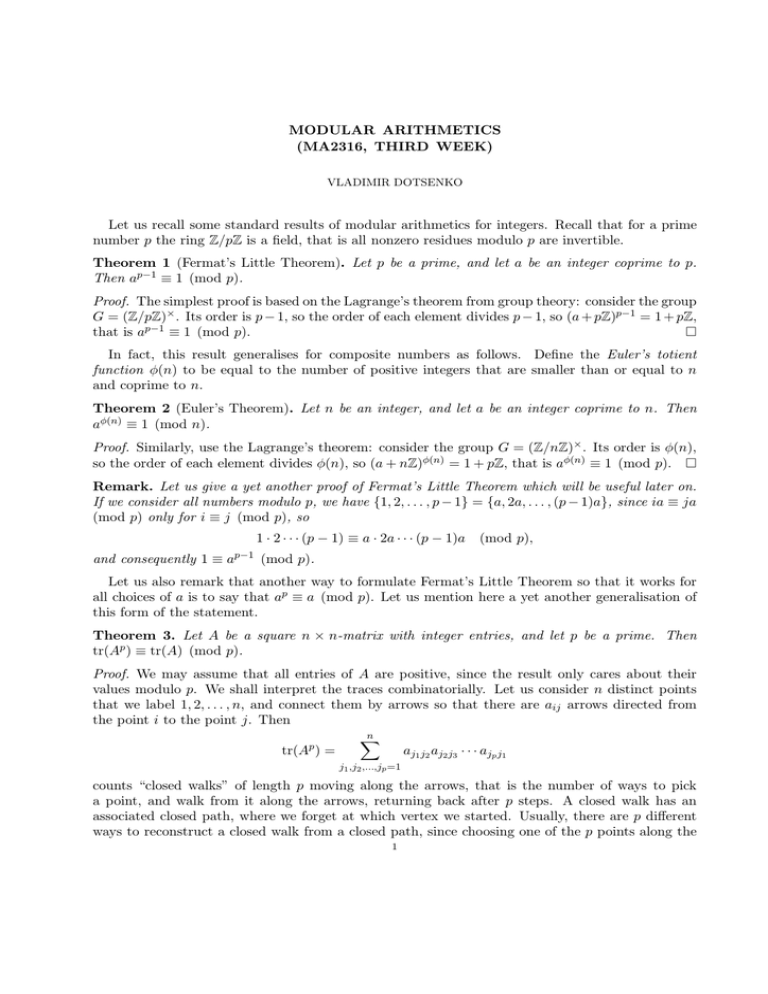MODULAR ARITHMETICS (MA2316, THIRD WEEK)
advertisement

MODULAR ARITHMETICS
(MA2316, THIRD WEEK)
VLADIMIR DOTSENKO
Let us recall some standard results of modular arithmetics for integers. Recall that for a prime
number p the ring Z/pZ is a field, that is all nonzero residues modulo p are invertible.
Theorem 1 (Fermat’s Little Theorem). Let p be a prime, and let a be an integer coprime to p.
Then ap−1 ≡ 1 (mod p).
Proof. The simplest proof is based on the Lagrange’s theorem from group theory: consider the group
G = (Z/pZ)× . Its order is p − 1, so the order of each element divides p − 1, so (a + pZ)p−1 = 1 + pZ,
that is ap−1 ≡ 1 (mod p).
In fact, this result generalises for composite numbers as follows. Define the Euler’s totient
function φ(n) to be equal to the number of positive integers that are smaller than or equal to n
and coprime to n.
Theorem 2 (Euler’s Theorem). Let n be an integer, and let a be an integer coprime to n. Then
aφ(n) ≡ 1 (mod n).
Proof. Similarly, use the Lagrange’s theorem: consider the group G = (Z/nZ)× . Its order is φ(n),
so the order of each element divides φ(n), so (a + nZ)φ(n) = 1 + pZ, that is aφ(n) ≡ 1 (mod p). Remark. Let us give a yet another proof of Fermat’s Little Theorem which will be useful later on.
If we consider all numbers modulo p, we have {1, 2, . . . , p − 1} = {a, 2a, . . . , (p − 1)a}, since ia ≡ ja
(mod p) only for i ≡ j (mod p), so
1 · 2 · · · (p − 1) ≡ a · 2a · · · (p − 1)a
(mod p),
and consequently 1 ≡ ap−1 (mod p).
Let us also remark that another way to formulate Fermat’s Little Theorem so that it works for
all choices of a is to say that ap ≡ a (mod p). Let us mention here a yet another generalisation of
this form of the statement.
Theorem 3. Let A be a square n × n-matrix with integer entries, and let p be a prime. Then
tr(Ap ) ≡ tr(A) (mod p).
Proof. We may assume that all entries of A are positive, since the result only cares about their
values modulo p. We shall interpret the traces combinatorially. Let us consider n distinct points
that we label 1, 2, . . . , n, and connect them by arrows so that there are aij arrows directed from
the point i to the point j. Then
n
X
aj1 j2 aj2 j3 · · · ajp j1
tr(Ap ) =
j1 ,j2 ,...,jp =1
counts “closed walks” of length p moving along the arrows, that is the number of ways to pick
a point, and walk from it along the arrows, returning back after p steps. A closed walk has an
associated closed path, where we forget at which vertex we started. Usually, there are p different
ways to reconstruct a closed walk from a closed path, since choosing one of the p points along the
1
path as the starting point leads to different walks. There is only one situation where it fails, that
is for walks that are repetitions of the same “loop” arrow from some vertex i to itself p times.
(Indeed, we can view our walk as an infinite p-periodic walk, and if it there are less than p different
ways to reconstruct the walk from its associated path, this means that it is periodic with a smaller
period, which for prime p implies that it has period 1), Thus the number of all p-periodic walks,
that is tr(Ap ), is congruent modulo p to the number of 1-periodic walks, that is tr(A).
Theorem 4 (Wilson’s Theorem). Let p be a prime. Then (p − 1)! ≡ −1 (mod p).
Proof. We have
1 · 2 · · · (p − 1) ≡ 1 · (p − 1) (mod p),
since modulo p the elements that are equal to their inverses are 1 and −1 = p − 1, and all other
elements in the product will cancel with their inverses.
Theorem 5. Let p be a prime. Then the group (Z/pZ)× is cyclic.
Proof. Let us show that if d | (p − 1), then the congruence xd ≡ 1 (mod p) has d solutions modulo
p. Indeed, since Z/pZ is a field, this congruence has at most d solutions (a polynomial of degree d
p−1 −1
over a field has at most d roots), and if their number is less than d, then the polynomial xxd −1
of
p−1
degree p − 1 − d would have too many roots (as by Fermat’s Little Theorem the polynomial x
−1
has p − 1 roots).
Let us denote by α(d) the number
of elements of order exactly d in the group (Z/pZ)× . Then,
P
our result can be formulated as c|d α(c) = d (since by Lagrange’s theorem, the order of an element
P
of a group G divides the number of elements of G). But we also have c|d φ(c) = d, since if we
look at fractions 1d , 2d , . . . , dd , and bring each of them to the lowest terms, exactly φ(c) of them will
have c as a denominator (the numerators will be precisely all integers smaller than or equal to c
that are coprime to c). From these two facts, it is easy to see by induction that α(c) = φ(c) for all
c | p − 1. In particular, α(p − 1) = φ(p − 1) ≥ 1 so there exists an element of order p − 1, and the
group is cyclic.
2






